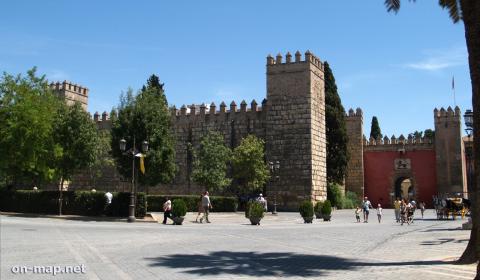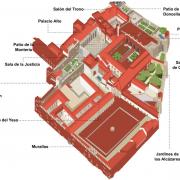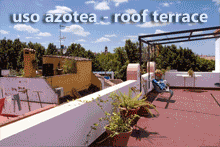Location in Spain:
Category:
All hotels of Seville in list | on a map
The Alcazar Palace (los Reales Alcazares) is definitly one of the most impressive monuments of Seville. You should not miss it when visiting the city! It is a fortified palace of which the construction was ordered by Abd Al Ramn III in the year 913. The Alcazar palace is considered World Heritage by UNESCO.
Because of it's beauty it was chosen as residence by many monarchs in the centuries that followed. It now is the residence of His Royal Majesty Juan Carlos when he visits Seville. Pedro I, "the cruel" (1350 to 1369), made significant additions to the palace which is one of the most important examples of Mudejar architecture in Seville. The numerous rooms, patios and halls vary in architectural styles from the Islamic to Neoclassical. The beautiful gardens and fountains are especially worth visiting.
Other important monuments in Andalusia
The Cordoba Mosque - The Alhambra Palace, Granada
Interesting areas within the Alcazar
- Salon de los Embajadores
(The Ambassadors Room): The magnificent dome of the Ambassadors Room is decorated with gilded cedar wood sculptures. - Arcos de Herradura (Horse shoe archs)
The Ambassadors Room is decorated with tiles and complex plaster work. It has three semetrical arcs each with three horse shoes. - El Patio de la Montera (The Hunting Patio)
This was the meeting place of the court before the hunt took place. The faade of the palace of Pedro I is a unique example of Mudejar design. - El Patio del Yeso (The Plaster Patio)
This beautiful, ornate garden full of flowers and streams maintains elements of the almohade architectural style of the Moors from the 12 century. - Patio de las Doncellas (Patio of the maidens)
This patio was decorated by the best architects in Granada. Patio del Crucero is above the ancient baths. - Salones de Carlos V (Rooms of Charles V)
The rooms and chapel of Charles V are decorated with tapestries and coloured tiles from 16 Century. - El Patio de las Muñecas (The Patio of the Dolls)
This patio with its bedrooms and adjacent corridors was the heart of the palace. It takes its name from the two tiny faces that decorate its arcs.
The Gardens of the Alcazar Palace
These gardens, adorned with fountains and pavilions, provide shelter from the hustle and bustle of Seville.
- Jardin Inglés (English gardens)
These gardens are modelled on those of the British Isles from 18 Century. The door to the Alcoba is of Islamic origin. The park was built in 1909 and the main gardener of the Real Casa de Campo, Juan Gras, was put in charge of planting the flowers. However, there are doubts as to whether his radical style fits in with the surroundings. - Jardin de los Poetas (The Garden of the Poets)
The design of this garden is similar to that of the Forestier thanks to the influence of Joaquin Romero Murube. It's most emblematic feature is the two ponds that were inspired by the Arabs and Romans. - Jardin de la Vega Inclan (Garden of Vega Inclan)
This is a well designed garden inspired by the Damas even though it lacks the refinement that had once existed. This garden consists of 20 mostly square flower beds that are separated by paths and fountains. These gardens took their inspiration from Islamic culture and the Renaissance. - Jardin de la Alcubilla (Garden of the Reservoir)
This garden existed during the time of Charles V.
All hotels of Seville in a list | on a map










